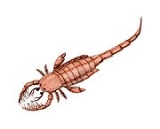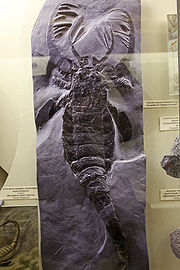
Mixopterus
Encyclopedia
Mixopterus is a genus
of a eurypterid
. It belongs to the family Mixopteridae.
 Mixopterus were characterised by a robust exoskeleton
Mixopterus were characterised by a robust exoskeleton
s with scattered tubercle
s or semicircular scales. The prosoma (head) was subquadrate, protruding antemedially. The chelicerae
(claws in front of the mouth) were small. The first two pairs of walking legs were strongly developed, with long paired spines. The third and fourth walking legs were moderately sized, with short spines. The preabdomen, the front portion of the body, was narrow with axial furrows, while the postabdomen was narrow. The telson
was a curved spine.
Genus
In biology, a genus is a low-level taxonomic rank used in the biological classification of living and fossil organisms, which is an example of definition by genus and differentia...
of a eurypterid
Eurypterid
Eurypterids are an extinct group of arthropods related to arachnids which include the largest known arthropods that ever lived. They are members of the extinct order Eurypterida ; which is the most diverse Paleozoic chelicerate order in terms of species...
. It belongs to the family Mixopteridae.
Description

Exoskeleton
An exoskeleton is the external skeleton that supports and protects an animal's body, in contrast to the internal skeleton of, for example, a human. In popular usage, some of the larger kinds of exoskeletons are known as "shells". Examples of exoskeleton animals include insects such as grasshoppers...
s with scattered tubercle
Tubercle
A tubercle is generally a wart-like projection, but it has slightly different meaning depending on which family of plants or animals it is used to refer to....
s or semicircular scales. The prosoma (head) was subquadrate, protruding antemedially. The chelicerae
Chelicerae
The chelicerae are mouthparts of the Chelicerata, an arthropod subphylum that includes arachnids, Merostomata , and Pycnogonida . Chelicerae are pointed appendages which are used to grasp food, and are found in place of the chewing mandibles most other arthropods have...
(claws in front of the mouth) were small. The first two pairs of walking legs were strongly developed, with long paired spines. The third and fourth walking legs were moderately sized, with short spines. The preabdomen, the front portion of the body, was narrow with axial furrows, while the postabdomen was narrow. The telson
Telson
The telson is the last division of the body of a crustacean. It is not considered a true segment because it does not arise in the embryo from teloblast areas as do real segments. It never carries any appendages, but a forked "tail" called the caudal furca is often present. Together with the...
was a curved spine.
Species
Three species are currently classified under the genus:- Mixopterus kiaeri Størmer, 1934 - Ringerike, Norway (Silurian)
- Mixopterus multispinosus (Clarke & Ruedemann, 1912) - New York (Silurian)
- Mixopterus simonsoni Schmidt, 1883 - Saaremaa, Estonia

